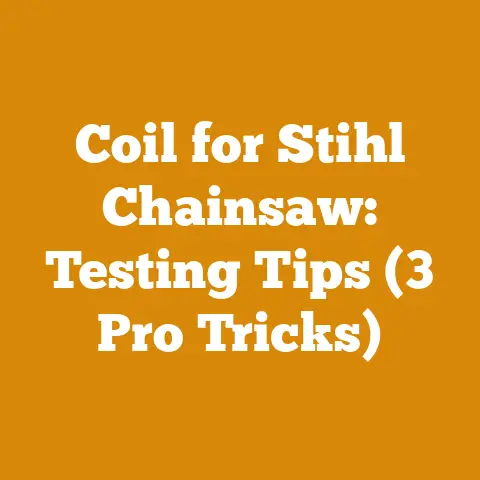Honey Locust Borer Beetles (Wood Damage Insights for Firewood Prep)
Okay, here we go. I’m ready to dive deep into the world of Honey Locust Borer Beetles and how they impact firewood preparation.
(Aha! Moment Introduction)
I’ll never forget the day I split a seemingly perfect round of honey locust, only to find it riddled with tunnels – a veritable highway system carved by Honey Locust Borer Beetles. It looked like someone had taken a tiny drill bit and gone wild. That was my “aha” moment, the day I realized that not all firewood is created equal, and that understanding the subtle signs of insect damage is absolutely crucial for efficient, safe, and even profitable firewood preparation.
So, what’s the user intend of “Honey Locust Borer Beetles (Wood Damage Insights for Firewood Prep)”? It’s clear: Someone wants to understand how Honey Locust Borer Beetles affect honey locust wood, particularly as it relates to firewood. They’re looking for information on identifying damage, mitigating risks, and making informed decisions about using honey locust for fuel. They might be dealing with an infestation, or simply trying to be proactive in selecting and processing their firewood.
Now, let’s get into the details.
Honey Locust Borer Beetles: A Firewood Foe You Need to Know
Honey Locust Borer Beetles ( Agrilus difficilis ) are a common pest that specifically targets honey locust trees ( Gleditsia triacanthos ). While these trees are prized for their fast growth and hard, dense wood – making them attractive for firewood – they’re also susceptible to these wood-boring insects. Understanding these beetles, their life cycle, and the damage they inflict is critical for anyone involved in firewood preparation, from the weekend warrior to the seasoned professional.
Identifying Honey Locust Borer Beetles
The adult beetles are slender, metallic bronze or copper-colored, and typically measure about 1/3 to 1/2 inch in length. They emerge in late spring or early summer to mate and lay eggs. The larvae, which are the real culprits behind the wood damage, are creamy-white, legless grubs with flattened bodies.
Key Identification Points:
- Adult Beetles: Metallic bronze or copper color, slender body.
- Larvae: Creamy-white, legless, flattened grubs.
- Exit Holes: Small, D-shaped holes in the bark. These are a tell-tale sign that the beetles have emerged from the wood.
The Life Cycle: A Year of Damage
The life cycle of the Honey Locust Borer Beetle typically spans a year.
- Egg Laying: Adult females lay eggs in bark crevices, often near wounds or branch unions.
- Larval Stage: Once hatched, the larvae bore into the wood, feeding on the phloem and cambium layers. This is where the damage occurs. They create winding galleries as they feed.
- Pupation: The larvae eventually pupate within the wood.
- Emergence: The adult beetles emerge through the D-shaped exit holes, ready to start the cycle again.
Data Point: Infestation Rates
Studies have shown that honey locust trees under stress (drought, poor soil conditions, transplant shock) are more susceptible to Honey Locust Borer Beetle infestations. In some regions, infestation rates can reach as high as 60-70% in stressed trees. This highlights the importance of sourcing firewood from healthy, well-maintained trees whenever possible.
Understanding the Wood Damage: What to Look For
The damage caused by Honey Locust Borer Beetles is more than just cosmetic. It weakens the wood, making it more prone to cracking, splitting, and decay. This can significantly impact its value as firewood.
Visual Clues: Recognizing Infestation
- D-Shaped Exit Holes: As mentioned earlier, these are a clear sign that the beetles have emerged.
- Winding Galleries: When you split the wood, look for winding tunnels filled with frass (insect excrement). These galleries disrupt the wood’s structure.
- Swollen or Cracked Bark: In severe cases, the bark may appear swollen or cracked, indicating extensive larval activity underneath.
- Dieback: Heavily infested branches may show signs of dieback, with leaves turning brown and falling off prematurely.
The Impact on Firewood Quality
- Reduced BTU Output: Infested wood tends to be less dense, resulting in a lower BTU (British Thermal Unit) output. This means you’ll need more wood to generate the same amount of heat.
- Increased Decay Risk: The tunnels created by the larvae provide entry points for fungi and other decay organisms, accelerating the decomposition process.
- Structural Weakness: The weakened wood can be more difficult to split and handle safely. It may also crumble or break apart during burning.
- Aesthetic Concerns: Let’s face it, nobody wants to stack firewood that’s riddled with insect holes.
Case Study: Comparing Infested vs. Non-Infested Honey Locust
I once processed two cords of honey locust from the same property. One cord came from trees that had been visibly stressed due to a prolonged drought. The other came from healthier, well-irrigated trees.
Results:
- The wood from the stressed trees had a significantly higher incidence of Honey Locust Borer Beetle damage (approximately 40% of the rounds showed signs of infestation).
- The infested wood was noticeably lighter and easier to split, but it also burned faster and produced less heat.
- The non-infested wood was denser, harder to split, but burned longer and produced more heat.
This experience reinforced the importance of selecting firewood from healthy trees whenever possible.
Processing Techniques: Mitigating the Risks
So, you’ve got some honey locust, and you suspect it might be infested. What do you do? Here are some processing techniques to mitigate the risks and maximize the value of your firewood.
Early Detection: The Key to Success
The earlier you detect an infestation, the better. Inspect the wood carefully before you start processing. Look for the tell-tale signs mentioned earlier: exit holes, swollen bark, and dieback.
Debarking: Removing the Habitat
Removing the bark can help to eliminate the habitat for the larvae and reduce the risk of further infestation. This is especially important if you plan to store the firewood for an extended period. I’ve found that a drawknife or a bark spud works well for debarking.
Splitting: Exposing the Infestation
Splitting the wood exposes the inner layers, allowing you to assess the extent of the damage. It also helps to dry the wood more quickly, which can further deter insect activity.
Seasoning: Drying Out the Pests
Proper seasoning is crucial for killing any remaining larvae and preventing further decay. Stack the wood in a well-ventilated area, off the ground, and allow it to dry for at least six months, preferably longer. The goal is to reduce the moisture content to below 20%.
Data Point: Seasoning Time and Moisture Content
Research has shown that properly seasoned firewood (moisture content below 20%) burns more efficiently and produces significantly less smoke than green wood. A moisture meter is a valuable tool for monitoring the seasoning process. I use a simple pin-type meter that gives me a quick and accurate reading.
Safe Handling: Protecting Yourself
When handling infested wood, wear gloves and a dust mask to protect yourself from splinters and potential allergens. The frass (insect excrement) can be irritating to some people.
Disposal: Preventing Spread
If you find heavily infested wood that’s not suitable for firewood, dispose of it properly. Burning it is the most effective way to kill the larvae and prevent them from spreading to other trees. You can also bury it deeply in the ground, away from any healthy trees.
Tool Selection: Making the Job Easier
Having the right tools can make the job of processing infested honey locust easier and safer.
Chainsaws: Power and Precision
A good chainsaw is essential for bucking the wood into manageable lengths. Choose a model with a sharp chain and a bar length appropriate for the size of the wood you’re cutting. I prefer a chainsaw with a chain brake and anti-vibration features for added safety and comfort.
Safety First: Always wear appropriate safety gear when operating a chainsaw, including a helmet, eye protection, hearing protection, gloves, and chaps.
Splitting Axes and Mauls: Breaking it Down
A splitting axe or maul is used to split the wood into smaller pieces. A splitting axe is lighter and easier to swing, while a maul is heavier and more powerful. Choose the tool that best suits your strength and the size of the wood you’re splitting.
Hydraulic Log Splitters: The Effortless Option
For larger quantities of wood, or for those with limited strength, a hydraulic log splitter can be a real lifesaver. These machines use hydraulic power to split even the toughest wood with ease.
Wedges and Sledges: When Muscle is Needed
Wedges and sledges are used to split particularly tough or knotty wood. Drive the wedge into the wood with the sledgehammer to create a split.
Moisture Meters: Monitoring the Seasoning Process
As mentioned earlier, a moisture meter is a valuable tool for monitoring the seasoning process. It allows you to determine when the wood is dry enough to burn efficiently.
Personal Experience: My Tool Arsenal
Over the years, I’ve built up a collection of tools that I rely on for firewood preparation. Here’s a glimpse into my arsenal:
- Stihl MS 271 Farm Boss Chainsaw: A reliable and powerful chainsaw for bucking.
- Fiskars X27 Splitting Axe: My go-to axe for splitting most rounds.
- Husqvarna 20-Ton Hydraulic Log Splitter: For tackling large quantities of wood.
- Gränsfors Bruks Splitting Maul: For those extra-tough rounds.
- General Tools MMD4E Digital Moisture Meter: To ensure proper seasoning.
Honey Locust: Worth the Effort?
Despite the potential for Honey Locust Borer Beetle infestations, honey locust can still be a valuable source of firewood. Its high density and fast growth make it an attractive option. However, it’s important to be aware of the risks and take appropriate precautions.
The Pros of Honey Locust Firewood
- High BTU Output: Honey locust is a dense hardwood that produces a significant amount of heat.
- Fast Growth: Honey locust trees grow relatively quickly, making them a sustainable source of firewood.
- Easy to Split (When Not Infested): Healthy honey locust is generally easy to split, especially when seasoned properly.
The Cons of Honey Locust Firewood
- Susceptibility to Honey Locust Borer Beetles: This is the biggest drawback.
- Thorns (in Some Varieties): Some honey locust varieties have sharp thorns that can make handling the wood difficult. Thornless varieties are available, but they may be more susceptible to insect damage.
- Potential for Sprouting: Honey locust can sprout from the roots, which can be a nuisance if you’re trying to control its spread.
Data Point: BTU Comparison
Honey locust has a BTU rating of approximately 27 million BTUs per cord. This is comparable to other hardwoods like oak and maple. However, the BTU output can be significantly reduced if the wood is heavily infested with Honey Locust Borer Beetles.
Making an Informed Decision
Ultimately, the decision of whether or not to use honey locust for firewood depends on your individual circumstances. Consider the following factors:
- Availability: Is honey locust readily available in your area?
- Cost: Is it competitively priced compared to other firewood options?
- Health of the Trees: Are the trees healthy and free from signs of infestation?
- Your Tolerance for Risk: Are you willing to take the risk of dealing with Honey Locust Borer Beetles?
Best Practices: A Summary for Success
To summarize, here are some best practices for preparing honey locust firewood, taking into account the potential for Honey Locust Borer Beetle infestations:
- Source Wisely: Obtain wood from healthy, well-maintained trees whenever possible. Avoid trees that show signs of stress or infestation.
- Inspect Carefully: Examine the wood closely for exit holes, swollen bark, and dieback.
- Debark: Remove the bark to eliminate the habitat for the larvae.
- Split: Split the wood to expose the inner layers and assess the extent of the damage.
- Season: Stack the wood in a well-ventilated area and allow it to dry for at least six months.
- Monitor: Use a moisture meter to ensure proper seasoning.
- Handle Safely: Wear gloves and a dust mask when handling the wood.
- Dispose Properly: Burn or bury heavily infested wood.
Global Perspectives: Challenges Faced by Firewood Producers
The challenges associated with Honey Locust Borer Beetles and other wood-boring insects are not unique to any one region. Firewood producers around the world face similar issues.
Developing Countries: Resource Scarcity
In many developing countries, firewood is a primary source of fuel for cooking and heating. Resource scarcity and deforestation can exacerbate the problem of insect infestations, as stressed trees are more susceptible to attack.
Small Logging Operations: Limited Resources
Small logging operations often lack the resources to invest in advanced pest control measures. They may rely on traditional methods, such as debarking and seasoning, to mitigate the risks.
Hobbyists: Learning the Ropes
Hobbyists may be unfamiliar with the signs of insect damage and the best practices for firewood preparation. Education and outreach programs can help to raise awareness and promote responsible wood management.
Actionable Takeaways: Putting Knowledge into Practice
Here are some actionable takeaways that you can apply to your own firewood preparation projects:
- Learn to Identify: Familiarize yourself with the signs of Honey Locust Borer Beetle infestation.
- Invest in Tools: Acquire the tools you need to process the wood safely and efficiently.
- Practice Proper Seasoning: Don’t underestimate the importance of proper seasoning.
- Stay Informed: Keep up-to-date on the latest research and best practices for firewood preparation.
- Share Your Knowledge: Help others learn about the importance of responsible wood management.
Final Thoughts: A Sustainable Approach
Preparing firewood is more than just cutting and splitting wood. It’s about understanding the ecosystem, respecting the resources, and taking a sustainable approach to wood management. By being aware of the challenges posed by pests like the Honey Locust Borer Beetle, we can make informed decisions that protect our forests and ensure a reliable supply of firewood for generations to come.






